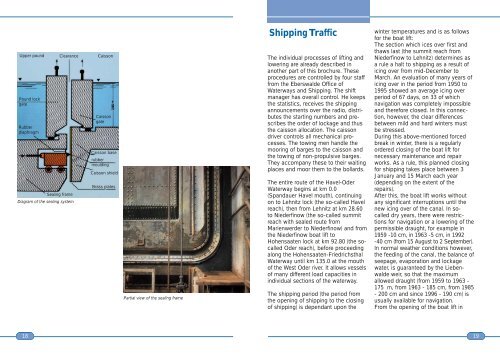Niederfinow boat lift - Wasser- und Schiffahrtsamt Eberswalde
Niederfinow boat lift - Wasser- und Schiffahrtsamt Eberswalde
Niederfinow boat lift - Wasser- und Schiffahrtsamt Eberswalde
You also want an ePaper? Increase the reach of your titles
YUMPU automatically turns print PDFs into web optimized ePapers that Google loves.
Upper po<strong>und</strong> Clearance Caisson<br />
Po<strong>und</strong> lock<br />
gate<br />
Rubber<br />
diaphragm<br />
18<br />
Sealing frame<br />
Diagram of the sealing system<br />
Caisson<br />
gate<br />
Caisson base<br />
rubber<br />
moulding<br />
Caisson shield<br />
Brass plates<br />
Partial view of the sealing frame<br />
Shipping Traffic<br />
The individual processes of <strong>lift</strong>ing and<br />
lowering are already described in<br />
another part of this brochure. These<br />
procedures are controlled by four staff<br />
from the <strong>Eberswalde</strong> Office of<br />
Waterways and Shipping. The shift<br />
manager has overall control. He keeps<br />
the statistics, receives the shipping<br />
announcements over the radio, distributes<br />
the starting numbers and prescribes<br />
the order of lockage and thus<br />
the caisson allocation. The caisson<br />
driver controls all mechanical processes.<br />
The towing men handle the<br />
mooring of barges to the caisson and<br />
the towing of non-propulsive barges.<br />
They accompany these to their waiting<br />
places and moor them to the bollards.<br />
The entire route of the Havel-Oder<br />
Waterway begins at km 0.0<br />
(Spandauer Havel mouth), continuing<br />
on to Lehnitz lock (the so-called Havel<br />
reach), then from Lehnitz at km 28.60<br />
to <strong>Niederfinow</strong> (the so-called summit<br />
reach with sealed route from<br />
Marienwerder to <strong>Niederfinow</strong>) and from<br />
the <strong>Niederfinow</strong> <strong>boat</strong> <strong>lift</strong> to<br />
Hohensaaten lock at km 92.80 (the socalled<br />
Oder reach), before proceeding<br />
along the Hohensaaten-Friedrichsthal<br />
Waterway until km 135.0 at the mouth<br />
of the West Oder river. It allows vessels<br />
of many different load capacities in<br />
individual sections of the waterway.<br />
The shipping period (the period from<br />
the opening of shipping to the closing<br />
of shipping) is dependant upon the<br />
winter temperatures and is as follows<br />
for the <strong>boat</strong> <strong>lift</strong>:<br />
The section which ices over first and<br />
thaws last (the summit reach from<br />
<strong>Niederfinow</strong> to Lehnitz) determines as<br />
a rule a halt to shipping as a result of<br />
icing over from mid-December to<br />
March. An evaluation of many years of<br />
icing over in the period from 1950 to<br />
1995 showed an average icing over<br />
period of 67 days, on 33 of which<br />
navigation was completely impossible<br />
and therefore closed. In this connection,<br />
however, the clear differences<br />
between mild and hard winters must<br />
be stressed.<br />
During this above-mentioned forced<br />
break in winter, there is a regularly<br />
ordered closing of the <strong>boat</strong> <strong>lift</strong> for<br />
necessary maintenance and repair<br />
works. As a rule, this planned closing<br />
for shipping takes place between 3<br />
January and 15 March each year<br />
(depending on the extent of the<br />
repairs).<br />
After this, the <strong>boat</strong> <strong>lift</strong> works without<br />
any significant interruptions until the<br />
new icing over of the canal. In socalled<br />
dry years, there were restrictions<br />
for navigation or a lowering of the<br />
permissible draught, for example in<br />
1959 -10 cm, in 1963 -5 cm, in 1992<br />
-40 cm (from 15 August to 2 September).<br />
In normal weather conditions however,<br />
the feeding of the canal, the balance of<br />
seepage, evaporation and lockage<br />
water, is guaranteed by the Liebenwalde<br />
weir, so that the maximum<br />
allowed draught (from 1959 to 1963 -<br />
175 m, from 1963 - 185 cm, from 1985<br />
- 200 cm and since 1996 - 190 cm) is<br />
usually available for navigation.<br />
From the opening of the <strong>boat</strong> <strong>lift</strong> in<br />
19


